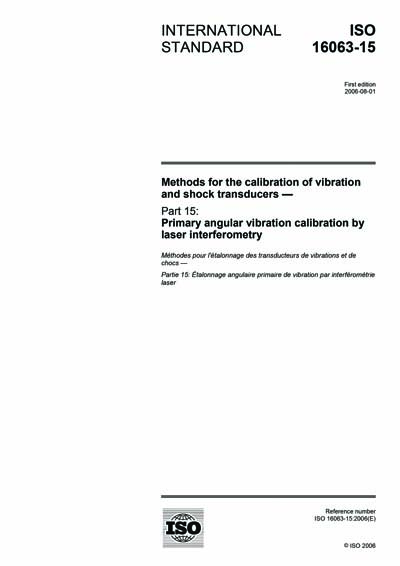Most recent
ISO 16063-15:2006
Methods for the calibration of vibration and shock transducers - Part 15: Primary angular vibration calibration by laser interferometry
ISO 16063-15:2006 specifies the instrumentation and procedures used for primary angular vibration calibration of angular transducers, i.e. angular accelerometers, angular velocity transducers and rotational angle transducers (with or without amplifier) to obtain the magnitude and the phase shift of the complex sensitivity by steady-state sinusoidal vibration and laser interferometry. The methods specified in ISO 16063-15:2006 are applicable to measuring instruments (rotational laser vibrometers in particular) and to angular transducers as defined in ISO 2041 for the quantities of rotational angle, angular velocity and angular acceleration.
ISO 16063-15:2006 is applicable to a frequency range from 1 Hz to 1,6 kHz and a dynamic range (amplitude) from 0,1 rad/s2 to 1 000 rad/s2 (frequency-dependent). Calibration frequencies lower than 1 Hz (e.g. 0,4 Hz, which is a reference frequency used in other International Standards) and angular acceleration amplitudes smaller than 0,1 rad/s2 can be achieved using method 3A or method 3B specified in ISO 16063-15:2006, in conjunction with an appropriate low-frequency angular vibration generator.
ISO 16063-15:2006 describes six methods. Method 1A ( fringe-counting, interferometer type A) and method 1B ( fringe-counting, interferometer type B) are applicable to the calibration of the magnitude of complex sensitivity in the frequency range of 1 Hz to 800 Hz and under special conditions, at higher frequencies. Method 2A (minimum-point method, interferometer type A) and method 2B (minimum-point method, interferometer type B) can be used for sensitivity magnitude calibration in the frequency range of 800 Hz to 1,6 kHz. Method 3A (sine-approximation method, interferometer type A) and method 3B (sine-approximation method, interferometer type B) can be used for magnitude of sensitivity and phase calibration in the frequency range of 1 Hz to 1,6 kHz. Methods 1A, 1B and 3A, 3B provide for calibrations at fixed angular acceleration amplitudes at various frequencies. Methods 2A and 2B require calibrations at fixed rotational angle amplitudes (angular velocity amplitude and angular acceleration amplitude vary with frequency).
Content Provider
International Organization for Standardization [iso]






